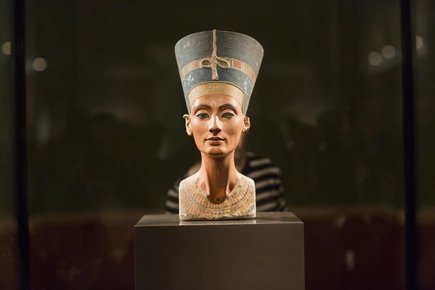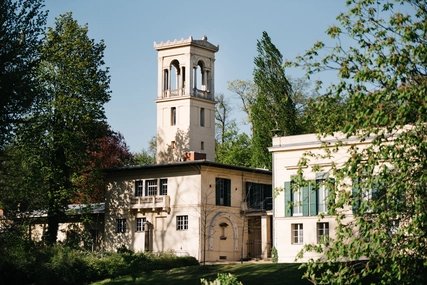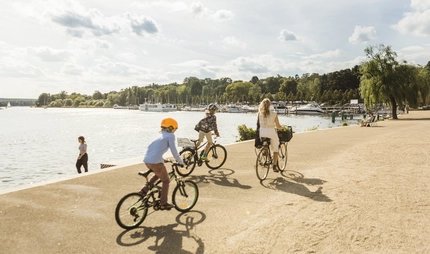
Bike tour Wannsee-Babelsberg Route
Cycling in the southwest of Berlin
Along the shores of the Wannsee and Havel you cycle through the UNESCO World Heritage Sites "Palaces and Parks of Potsdam and Berlin" and pass places steeped in history. The Wannsee-Babelsberg Route starts at Wannsee S-Bahn station. Via the Ronnebypromenade and the street Am Großen Wannsee you go along the lakeside promenade to Glienicke and Babelsberg and via Griebnitzsee and Stölpchensee back to Wannsee S-Bahn station.
Tip: Combine the Wannsee Route with other tours in southwest Berlin, such as the Dahlem Route or the Nikolassee Route. You can also book guided bicycle tours on all routes.
In addition to beautiful nature on the idyllic banks of the Havel, you cycle past many sights worth a stop:
Liebermann Villa

In the summer house of the painter Max Liebermann, a museum with a permanent exhibition of the artist's works created at Wannsee awaits you. In a documentary exhibition you will also learn about the life and work of Max Liebermann, one of the most important representatives of German Impressionism. At the Café Max you can enjoy a beautiful view over the garden and the Wannsee with hot and cold drinks and delicious cakes.
House of the Wannsee Conference

The house of the Wannsee Conference is just 400 metres away. The villa, built in 1914, is situated in a rural idyll on the shores of Lake Wannsee, but its appearance is deceptive: in 1942 the National Socialists organised one of mankind's greatest crimes, the Shoah, here. Today, the House of the Wannsee Conference is a museum that provides information on the planning, execution and perpetrators of the deportations and mass murders.
Flensburger Löwe

The monument, erected in 1874, is a heavy zinc cast of the original lion statue standing in Flensburg. The original commemorates the campaign in which the Danes defeated the rebellious Schleswig-Holsteins in 1850. In order to decorate his newly founded villa quarter, banker Wilhelm Conrad had the copy made. For him, the lion was a symbol of victory. However, the lion has only been standing at its present location since 1938 and looks heroically down on the Wannsee. From there you can also enjoy a wonderful view over the water.
Bathing area Alter Hof
Continue along the banks of the lower Havel river to the Alter Hof bathing area. Here you can make a stopover and jump into the cool water for a round while enjoying excellent water quality. So don't forget to pack your swimsuits!
Pfaueninsel

(Pfaueninsel Castle closed until 2024 due to extensive renovation work)
The small island that now lies in front of you in the Havel is the Pfaueninsel. The romantic gem, with the summer palace built in 1794 by Friedrich Wilhelm II, is part of the UNESCO World Heritage. As the name says, the island is inhabited by peacocks and invites you to take a romantic stroll. The ferry to Pfaueninsel departs about 1.5 kilometres from the Alter Hof bathing area. However, you are not allowed to take your bicycles with you to the island, but there are plenty of bicycle stands at the ferry landing stage. Let the idyll and tranquillity of the island work its magic on you during a walk and then enjoy delicious meals in the inn near the ferry landing stage.
St. Peter and Paul Church
The church built by King Friedrich Wilhelm III on Nikolskoe in 1837 invites you to pause for a moment on the bicycle tour. Like the blockhouse, the former Royal Free School and the Pfaueninsel cemetery, it is part of the UNESCO World Heritage Site. The surrounding forest is also listed. You can admire the buildings from the promenade or walk up to the small hill.
Sacrower Heilandskirche

If you continue along the promenade, you will soon recognise the Sacrower Heilandskirche on the opposite bank. The church, built in 1844 by Friedrich Wilhelm IV, in Italian style with a freestanding bell tower, was located in the area of the Berlin Wall in 1961 and suffered great damage. Restored in the 1990s, the Sacrower Heilandskirche also belongs to the UNESCO World Heritage. The beautiful church is a feast for the eyes both from the outside and the inside.
Glienicker Brücke
Today the bridge over the Havel river marks the border between Berlin and Brandenburg. It connects the Berlin suburb with Potsdam. If you take a closer look, you will see different kinds of paints on the eastern and western sides of the bridge. During the division of Germany, the middle of the Glienicker Brücke divided West Berlin from the GDR. Hardly any other bridge went down in the history of the Cold War as well as this one: here agents of the Warsaw Pact who had been captured were exchanged for Western spies who had been blown up. This is why the bridge is nicknamed the "Bridge of Spies" - You probably know it from the famous movie "Bridge of Spies" directed by Steven Spielberg. From the bridge you can enjoy a beautiful view of Babelsberg Park and Glienicke Park.
Glienicke Palace and Glienicke Park

Bella Italia in Berlin: The Glienicke palace is not far from the Glienicker Brücke. This classicist villa with Mediterranean charm will quickly makes you forget that you actually are on the outskirts of Berlin. After a journey through Italy in 1823, Prince Carl of Prussia had built the Glienicke palace and the Glienicke park. From the park you can see the Glienicker Brücke and the Havel. The park and Glienicke palace are UNESCO World Heritage Sites. You can also visit the palace from the inside.
Jagdschloss Glienicke
Within sight of Glienicke Palace lays the Jagdschloss Glienicke. Built in 1693 for the Elector Friedrich Wilhelm of Brandenburg, the castle had a wide range of uses: in addition to a soldier's hospital, wax cloth wallpaper factory and orphanage, it was already a residence and youth hostel. Since 2003 the rooms are used by the Social Pedagogical Training Institute Berlin-Brandenburg. The park is open to the public.
Babelsberg Palace

(Rooms of the castle Babelsberg will be renovated starting in 2020)
The tour continues over the Parkbrücke over the Teltow Canal to the Babelsberg Palace. Emperor Wilhelm I and his wife Augusta resided in the neo-Gothic castle of Babelsberg for over 50 years in summer. From here you can enjoy one of the most beautiful views of the Berlin and Potsdam castles and feel like the emperor and emperess yourself. The garden and park of the palace were lavishly laid out by prominent gardeners under the strict eyes of Princess Augustine. Fortunately, the castle survived both world wars unscathed and was used differently in the GDR. Babelsberg Castle and Park are also part of the UNESCO World Heritage. Here, too, you can interrupt your bicycle tour and jump into the cool water at the Babelsberg lido at Tiefen See.
Villenkolonie Neubabelsberg
The tour continues along the shores of the Griebnitzsee. Here you can admire magnificent villas in the Villenkolonie Neubabelsberg. The Villa Lademann, which served as the guest house of Ufa, one of the oldest film companies in Europe, where Marlene Dietrich and Heinz Rühmann already spent the night, the Landhaus Guggenheim, which belonged to the Jewish silk manufacturer Guggenheim, offering shelter to Erich Kästner, and the Villa Erlenkamp (today Villa Truman), in which Henry Truman spent the night during the Potsdam Conference and allegedly decided to drop the atomic bomb over Nagasaki and Hiroshima, are among the most famous houses of the Villenkolonie Neubabelsberg. The other negotiating partners of the Potsdam Conference, Winston Churchill and Josef Stalin, were also accommodated in Neubabelsberg during the Potsdam Conference. So take a tour of the villa colony and discover real architectural treasures of the imperial era.
Wall Memorial Griebnitzsee
Along the Griebnitzsee you can still see some remains of the Berlin Wall and memorials for murdered Wall refugees at the Wall Memorial Griebnitzsee. The wall parts of the Griebnitzsee Wall Memorial are the only original remains on the outer ring of the Wall that have been preserved under a preservation order.
Church on the Stölpchensee
Via the Teltow Canal you will cycle back to Berlin to the Stölpchensee. In the old village centre of Stolpe stands the church on the Stölpchensee, which was consecrated in 1859. In the bell tower, a mechanical glockenspiel plays a chorale every hour on the hour. In the garden of the church there is an exhibition on Christian plant symbolism.
Kleist-Memorial
The last memorial you cycle past on the Wannsee-Babelsberg Route is the Kleist-Memorial: in 1811 the playwright, poet and publicist Heinrich von Kleist, plagued by money worries and self-doubt, commits suicide on the shores of the Kleiner Wannsee. First he shot his good friend Henriette Vogel, who is suffering from cancer, and then himself. Both are buried at the scene.
At the end of the Wannsee-Babelsberg Route you will arrive back at the starting point, the S-Bahnhof Wannsee, from where you can take the S1 back to Berlin. Alternatively, you can start or end the route at Griebnitzsee or Babelsberg S-Bahn station and connect it with the Nikolassee Route or the Dahlem Route.
Sights off the Wannsee-Babelsberg Route

In addition to the many interesting and exciting monuments and sights along the Wannsee-Babelsberg Route, there is also plenty to discover aside from the actual tour.
Film fans should not miss the Filmpark Babelsberg, not far from the S-Bahn station Griebnitzsee. Also the Pfaueninsel is worth a visit. You can get there with the ferry departing from the Uferpromenade of the Havel. From the Wannsee landing stage, various boat tours depart on the Wannsee. Therefore you can also explore the picturesque southwest of Berlin from the water. The Wannsee-Babelsberg Route also crosses the famous Berlin Wall bike tour, on which you can continue your bicycle tour and learn interesting facts about the Berlin Wall and its course.
The village of Wannsee and Babelsberg invite you to stroll, eat and drink in cafés and restaurants.
Length of track: 19, 3 km
Travel time: 1 hour, 18 minutes
Nature of the path: cycle paths, roads, forest paths



